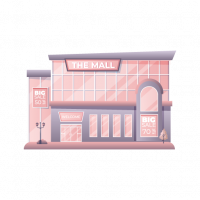Immersive Marketing | Mall Media | Customer Engagement | Digital

In a world increasingly dominated by e-commerce, traditional retail spaces like malls are reinventing themselves to stay relevant. One of the most exciting and promising approaches emerging in recent years is immersive marketing. By creating interactive and engaging experiences, brands are captivating consumers like never before. But what exactly is immersive marketing, and why is it becoming so popular in malls?
What is Immersive Marketing?
Immersive marketing is a strategy that places consumers at
the center of a memorable experience, blending elements of physical and digital
engagement. Instead of passively viewing advertisements, shoppers become active
participants. Whether through virtual reality (VR) installations, augmented
reality (AR) experiences, or experiential pop-up stores, immersive marketing
transforms mundane shopping trips into captivating journeys.
Why Malls are the Ideal Venue
Malls are uniquely positioned to benefit from immersive
marketing for several reasons. Firstly, they are social hubs, drawing in
diverse crowds looking for entertainment and shopping in one place. Secondly,
with large, versatile spaces, malls can accommodate extensive setups, including
interactive displays and live events. Lastly, malls are increasingly
transforming into lifestyle destinations rather than just retail centers,
making them perfect for experiential marketing.
The Key Benefits of Immersive Marketing in Malls
- Increased
Foot Traffic: Eye-catching experiences draw more visitors, boosting
foot traffic and overall mall vitality.
- Enhanced
Customer Engagement: Hands-on experiences foster deeper connections
between brands and consumers.
- Social
Media Amplification: Unique and shareable experiences often go viral,
generating free online exposure.
- Higher
Conversion Rates: Interactive setups encourage spontaneous purchases
and brand loyalty.
Real-World Examples
One of the most notable examples is Nike’s immersive store
experience, where customers can test products through AR simulations.
Similarly, Samsung’s experiential spaces allow visitors to engage with the
latest technology hands-on.
Challenges to Consider
Despite its benefits, implementing immersive marketing in
malls comes with challenges. High installation costs, technological glitches,
and maintaining audience interest over time are critical considerations.
However, brands that strike the right balance between innovation and
practicality can overcome these obstacles.
Conclusion
Immersive marketing in malls is not just a passing fad but a
strategic evolution in retail. As brands continue to innovate, malls will
remain at the forefront of consumer engagement, offering unique experiences
that online platforms simply cannot replicate. For retailers looking to stay
ahead, investing in immersive marketing is not just an option—it’s a necessity.






















Leave a Comment